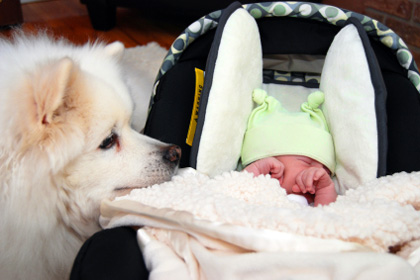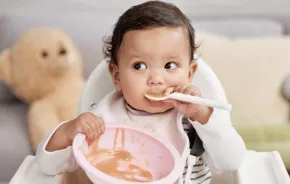 Unfortunately, as a dog trainer I often get calls from clients whose dog has bitten their new baby. None of these folks are bad dog owners or negligent parents, but there were definitely some things (“If they had only known...”) they could have done with their dogs that could have prevented the bites. There are five main areas to consider when preparing your dog for your baby’s arrival and their first few months of infancy:
Unfortunately, as a dog trainer I often get calls from clients whose dog has bitten their new baby. None of these folks are bad dog owners or negligent parents, but there were definitely some things (“If they had only known...”) they could have done with their dogs that could have prevented the bites. There are five main areas to consider when preparing your dog for your baby’s arrival and their first few months of infancy:
1. General Safety Precautions
- Dogs are sensitive to movement (some breeds more so than others) and babies and children move erratically.
- Most commonly bitten are toddlers, by a dog who is cornered, eating, or sleeping.
- Never leave baby and dog unattended — any dog pushed or cornered can lash out.
- Give your dog his own space that is off limits to baby. A crate is particularly helpful in a home with children.
- Be careful of common household hazards such as a food bowl (choking hazard) or a water bowl (drowning hazard).
- Be sure to get a dog-proof diaper container.
- Toys — some baby and dog toys are similar. Make sure your dog has her own toys that she is used to and has already formed a habit of chewing on.
2. Health Care
- De-worm dogs on a regular basis.
- Don’t let your dog (or baby!) drink standing water outside.
- Keep your dog healthy and treated for fleas and mites.
- Keep your dog’s nails trimmed and filed.
- Keep baby away from dog feces — that means picking up the poop in the yard immediately. As soon as your child becomes mobile, he will find it!
3. Desensitization
- Practice desensitization where your dog needs it. Desensitization = pairing treats or something “good” (whatever that is for your dog) with a "scary" stimulus, i.e. something that makes your dog nervous or uncomfortable.
- Practice handling exercises — handle your dog (especially ears, feet, and tail) while simultaneously giving him delicious treats.
- Desensitize your dog to baby sounds. You can buy recorded sounds and gradually expose (and habituate) your dog to these sounds.
- Desensitize your dog to baby equipment and toys (especially things that move or make noise like swings, strollers, rattles, etc.)
- Desensitize your dog to babies and children — when kids are around so are treats!
4. Exercise
- The standard recommendation for a young active dog is 30-45 minutes of hard exercise twice a day, preferably one leashed walk and one free play session (dog park, game of fetch, etc.).
- Cash in your favors here! When people ask what they can do for you after the baby is born, ask them to walk your dog, take him to the park, or toss a ball to him in the backyard.
- Work on teaching your dog to walk on a loose leash NOW!
- Learn how to walk with baby in tow:
- Get your dog used to appropriate equipment such as head collars or front clip harnesses to make your walks easier.
- Consider wearing your baby in a body carrier instead of a stroller so you are "hands free."
5. Training
- Teach your dog simple control commands: Sit, Down, Stay and Wait
- Wait is a command that is especially important when the dog is off-leash or getting ready to head out the door; the command is simply not allowing your dog to move forward. It is different than stay in that you do not care what position the dog is in (standing, sitting, lying down), you just do not want him to proceed forward.
- Practice “Wait” going in/out of all doorways, the dog's crate, and especially the car.
- Teach your dog not to jump up and work on other attention-seeking behaviors. Now is the time to ignore these behaviors and teach alternate behaviors (for example: "Sit" for greeting instead of jumping up).
- Teach your dog to “Go to your rug/bed/kennel.”
- Teach your dog "Leave it!" (item not yet in his mouth) and "Drop" (to release something already in his mouth).
- Teach your dog to walk on a loose leash.
- Enroll in a good basic obedience class now while you still have the time — add that to your list of baby classes you need to take!
Seeing your beloved dog and your new baby live and grow together is an amazing thing — get prepared, be safe, and enjoy it!
 Danette Johnston, a Licensed Veterinary Technician (LVT) in the state of Washington and a Certified Pet Dog Trainer (CPDT), owns and operates Dog’s Day Out, a dog training and daycare facility in Seattle. She has published articles on dog day care and dog-on-dog interactions for The Society of Veterinary Behavior Technicians and the Association of Pet Dog Trainers (APDT). She has lectured on dog behavior to Veterinary Technicians and students at the Society of Veterinary Behavior Technicians conference. Danette is also a Licensed Canine Good Citizen evaluator for the AKC and has worked as a Delta Society Pet Partner’s (animal assisted therapy) Instructor and Team (with her dear departed dog Georgia). She shares her home with two cats, one dog, a preschooler, and a very tolerant husband. Find them on Facebook and Twitter: @DDOSeattle.
Danette Johnston, a Licensed Veterinary Technician (LVT) in the state of Washington and a Certified Pet Dog Trainer (CPDT), owns and operates Dog’s Day Out, a dog training and daycare facility in Seattle. She has published articles on dog day care and dog-on-dog interactions for The Society of Veterinary Behavior Technicians and the Association of Pet Dog Trainers (APDT). She has lectured on dog behavior to Veterinary Technicians and students at the Society of Veterinary Behavior Technicians conference. Danette is also a Licensed Canine Good Citizen evaluator for the AKC and has worked as a Delta Society Pet Partner’s (animal assisted therapy) Instructor and Team (with her dear departed dog Georgia). She shares her home with two cats, one dog, a preschooler, and a very tolerant husband. Find them on Facebook and Twitter: @DDOSeattle.









